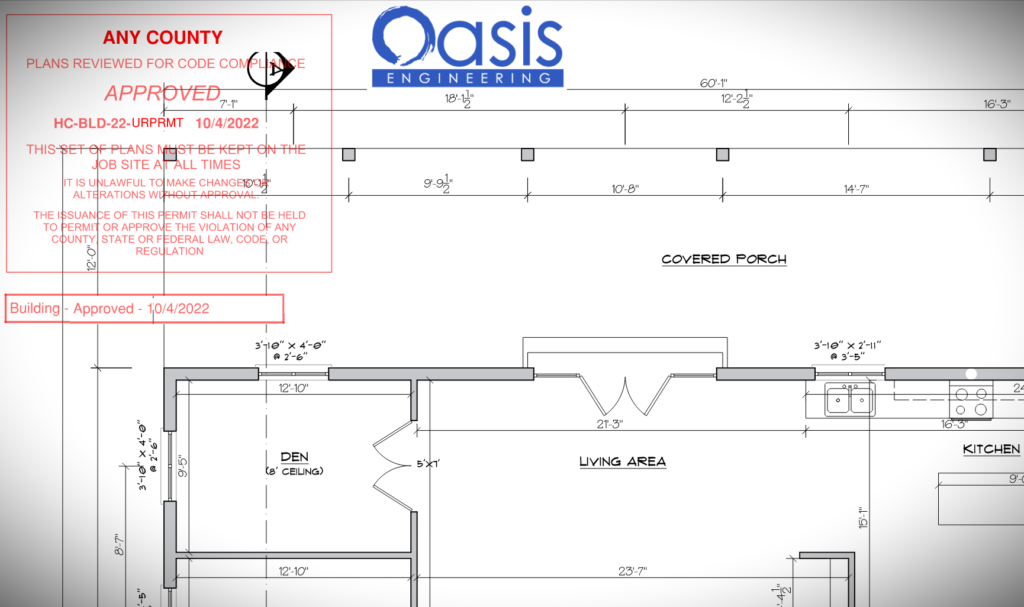If you’re planning to build or renovate, you’ll need to get a permit. That’s because building departments in cities and counties all over the country require permits for residential and commercial construction, including renovations and certain upgrades and installations.
While each jurisdiction has its own building codes and requirements, there are some common procedures that apply in most places. To help ensure that structures meet safety standards, building departments require:
- A permit application filed with complete plans and specifications — usually on official forms provided by the city or county’s department of public works or planning office.
- A fee for processing permits (which varies by jurisdiction).
- Proof that work was done according to plans filed with the city or county permitting office (for example, a final inspection report).

What type of work needs permits?
Most building codes will require a permit to construct, enlarge, alter, repair, move, demolish or change the occupancy or occupant content of a building or structure or make changes to any of the electrical, gas, mechanical or plumbing systems, the installation of which is regulated by the technical codes.
Work that requires an inspection to verify compliance with the applicable technical code requires a construction permit.
It is important to note that separate electrical, mechanical or plumbing permits may be required even if a building permit is not required.
We recommend consulting with a qualified professional before starting any work. It is possible that a permit may be required in your jurisdiction.
The following items are examples of work that in some areas may not require a permit.:
- Air conditioning and heating unit repairs.
- Air conditioning window unit replacement with existing electrical.
- Ceiling fan replacement using existing outlet box and wiring.
- Door replacement for any interior, or residential door within the individual unit.
- Gutters and leaders.
- Carpet installation, installation of floor/wall ceramic tiles, painting/wallpaper installations.
- Plumbing fixture replacements.
- Residential appliance replacements.
- Residential drywall repairs that are not fire-related and are for small areas that do not exceed two sheets of drywall.
- Residential playground equipment.
- Single-family home and condominium replacement of existing countertops and sinks that are going back in the same location (bathroom vanity, and kitchen cabinetry replacement in single-family and condominiums does require a permit).
- Window repairs.
- Installation of drywall in a detached garage without habitable space.
Steps to Permitting
Permit Application
A permit application is a request to the local government or other appropriate authority for permission to proceed with a construction or renovation project. The specific requirements for a permit application can vary depending on the jurisdiction and the type of project involved, but generally, you will need to provide the following information:
- Project description: This should include a detailed description of the work you plan to do, including the scope of the project and any changes you plan to make to the existing structure.
- Engineering plans: You will typically need to provide detailed construction plans that show the layout of the project, including floor plans, elevations, and details of any structural, electrical, or plumbing work.
- Supporting documentation: This may include building codes, engineering reports, or other technical information that is needed to review your application. A notarized Notice of Commencement
- Fees: Most jurisdictions require payment of a fee to cover the cost of reviewing and processing your permit application.
It is important to carefully review the requirements for a permit application in your jurisdiction and to provide all the necessary information and documentation to ensure that your application is processed efficiently.
I applied for a permit…now what?
Once you have received a permit for your construction project, you can typically begin construction as long as you comply with any conditions or requirements specified in the permit. However, it is important to carefully review the permit and make sure you understand all the requirements before you begin work.
Here are some steps you can take to ensure that your construction project proceeds smoothly:
- Review the permit: Make sure you understand all the requirements and conditions of the permit, including any requirements for inspections or other approvals.
- Gather all the necessary materials and equipment: Make sure you have everything you need to complete the project, including any special tools or equipment that may be required. Remember, always keep a copy of the permit card and the approved engineering permit plans, on site, at all times.
- Hire a contractor or assemble a team: If you are not planning to do the work yourself, you will need to hire a contractor or assemble a team of workers to complete the project.
- Develop a construction schedule: Create a schedule that outlines the steps you will take to complete the project, including any required inspections or other approvals. Schedules are a great tool to monitor progress and stay on top of milestones and goals. Great planning leads to great projects!
- Follow all safety guidelines: Make sure you follow all safety guidelines and use proper protective equipment to ensure the safety of yourself and anyone else working on the project. This should always be #1.
By following these steps and being diligent in following the requirements of your permit, you can help ensure that your construction project proceeds smoothly and is completed on time.
Permit Inspections
Permit inspections are an important part of the construction process, as they help ensure that the work being done meets all applicable building codes, standards and the approved (permitted) engineering plans. During a permit inspection, a building official or other qualified inspector will visit the construction site to review the work that has been done and verify that it meets the requirements of the permit.
Here is a general overview of how permit inspections typically work:
- Schedule the inspection: Before starting the work, you will need to schedule an inspection with the local building department or other appropriate authorities. You will typically be required to provide information about the type of work being done and the stage of construction that will be inspected.
- Prepare for the inspection: Make sure the construction site is clean and safe, and that all required documentation and plans are readily available for the inspector to review.
- Complete the work: Perform the work in accordance with all applicable building codes and the requirements of the permit.
- Request the inspection: Once the work is complete, or at the appropriate stage of construction, request an inspection by contacting the building department or other appropriate authority.
- Pass the inspection: If the work meets the requirements of the permit and all applicable building codes, the inspection will be passed and you can proceed with the next stage of construction. If the work does not meet the requirements, the inspector will provide a list of required corrections that must be made before the next inspection can be scheduled.
Permit inspections are an important part of the construction process, and it is important to ensure that all work is completed to the required standards to avoid delays or costly corrections.
FAQ
What is the typical cost of permit application and permitting fees?
The cost of permits for a home construction project will vary depending on a number of factors, including the scope of the project, the location of the property, and the specific building codes and regulations that apply to your area. In general, the cost of building permits can range from a few hundred dollars to several thousand dollars, depending on the complexity of the project. In most cities and building department, the permitting fees paid for their service typically ends up being about 1-2% of the project cost.
There are several different types of permits that may be required for a home construction project, and the cost of each permit will depend on the specific requirements of the project. For example, a building permit for a simple remodeling project may cost a few hundred dollars, while a building permit for a new construction project may cost several thousand dollars. Other types of permits that may be required for a home construction project include electrical, plumbing, and mechanical permits, which may also have associated fees.
To get an idea of the typical cost of permits in your area, you can contact your local building department or check their website for information on permit fees. You can also discuss the cost of permits with your contractor or a licensed engineer, who can help you understand the specific permit requirements for your project and provide an estimate of the costs involved.
Can I obtain a Permit After the Construction is Complete?
In most cases, you will need to obtain the necessary permits before starting construction on a project. This is because the permit process is designed to ensure that all construction projects meet the required safety and building codes, and that any necessary inspections are conducted during the construction process.
If you have completed construction without obtaining the necessary permits, you may have difficulty obtaining a permit after the fact. This is because the building department will need to review the completed work to ensure that it meets the required codes and standards. If the work does not meet these requirements, you may be required to make costly repairs or modifications to bring the structure up to code.
In some cases, it may be possible to obtain a permit after construction is complete, but this will depend on the specific circumstances of your project and the regulations in your area. You should consult with your local building department to discuss your options and see if it is possible to obtain a permit after construction is complete. Keep in mind that obtaining a permit after construction may be more difficult and time-consuming than obtaining one before construction starts, and you may be required to pay additional fees or fines.
We have helped many homeowners and contractors obtain permits before, during, or after construction. Sometimes homeowners are not aware of permit requirements or forget to apply for a permit, and end up being required by the Building Department to get a permit to avoid additional violation fees. In either case, we can help! We've done it before and we are familiar with the requirements to obtain after-the-fact permits.
How long does it take to process a permit for a home improvement project?
The length of time it takes to process a permit for a home improvement project can vary greatly depending on a number of factors, including the type and scope of the project, the jurisdiction in which the project is located, and the workload of the permitting agency. In general, it is best to allow for plenty of time to complete the permitting process, as it can take several weeks or even months to review the permit application and obtain all the necessary approvals.
Here are some steps you can take to help ensure that your permit application is processed as efficiently as possible:
- Gather all the necessary documentation: This typically includes construction plans, building codes, and any other relevant information that will be needed to review your application.
- Submit your application and pay any fees: Make sure you submit your application and pay any fees in a timely manner to avoid any delays.
- Follow up with the permitting agency: If you have any questions or concerns about the status of your application, don't be afraid to reach out to the agency to inquire.
- Be prepared to make any necessary changes: If the permitting agency requests changes to your plans or documentation, be prepared to make them in a timely manner to avoid delays.
Overall, it is important to be patient and proactive in the permitting process to ensure that your home improvement project can move forward smoothly. If you are having any issues with getting a permit approved or are being required additional information, let us know and we will be happy to help!
What is a Notice of Commencement (NOC)?
A Notice of Commencement is a legal document that is filed with the local government or other appropriate authority when construction or other development work is about to begin on a property. The purpose of a Notice of Commencement is to provide official notice that the work is beginning, and to establish the date on which the work began.
In most jurisdictions, a Notice of Commencement is required for all construction or development projects, regardless of size. The specific requirements for a Notice of Commencement can vary depending on the jurisdiction, but generally, it will include the following information:
- The name and address of the owner of the property.
- The name and address of the contractor or developer responsible for the work.
- A description of the work to be done.
- The estimated value of the work.
- The date on which the work is expected to be completed.
A Notice of Commencement is typically filed at the beginning of the project, and it may be required to be posted on the property in a visible location.
What is an Owner-Build Permit?
An owner-builder permit is a type of building permit that allows a homeowner to act as their own general contractor and oversee the construction of their own home or other building projects. In most jurisdictions, owner-builders are required to obtain an owner-builder permit before they can begin construction on their own property.
To qualify for an owner-builder permit, homeowners generally need to meet certain criteria, such as demonstrating that they have the necessary skills and experience to oversee the construction project, and providing proof of liability insurance. In some cases, homeowners may also be required to complete an owner-builder course or other training programs.
Once an owner-builder permit has been issued, the homeowner is responsible for managing all aspects of the construction project, including hiring subcontractors, ordering materials, and obtaining any necessary inspections or approvals. It is important for owner-builders to carefully review all the requirements and conditions of their permit and to follow all applicable building codes and regulations to ensure that their project is completed safely and in compliance with all relevant laws.
When are Stamped Plans Needed?
Professional engineering plans are typically stamped when they are used to obtain a building permit or when they are submitted for review by a regulatory agency. In many jurisdictions, plans must be stamped by a licensed professional engineer in order to be considered valid. The purpose of stamping the plans is to certify that the plans have been reviewed and approved by a licensed professional engineer and that they meet the required codes and standards.
In general, engineering plans are required for any construction project that involves the design or modification of structural, mechanical, electrical, or plumbing systems. This includes new construction, renovations, and repairs. Professional engineering plans may also be required for projects that involve the installation of specialized equipment or systems, such as elevators, HVAC systems, or electrical panels.
In order to stamp professional engineering plans, the engineer must hold a valid license in the state or jurisdiction where the project is located. The engineer must also be registered as a professional engineer in the appropriate discipline, such as civil, mechanical, electrical, or structural engineering. Once the plans have been reviewed and approved, the engineer can stamp them with their professional seal, which serves as a sign of their endorsement of the design.
Let us know if we can help with your next project!


